U.S. Supreme Court conservatives lean toward Trump over rapid deportation
WASHINGTON (Reuters) - Conservative U.S. Supreme Court justices appeared sympathetic on Monday toward a bid by President Donald Trump’s administration to buttress its power to quickly deport illegal immigrants without court interference in a politically charged election-year case concerning one of Trump’s signature issues.
The justices heard arguments in the administration’s appeal of a lower court ruling that a Sri Lankan asylum seeker - a farmer named Vijayakumar Thuraissigiam - had a right under the U.S. Constitution to have his case reviewed by a federal court.
Conservative justices signaled support for the administration. Liberal justices appeared to back Thuraissigiam. The court has a 5-4 conservative majority including two justices appointed by Trump.
The San Francisco-based 9th U.S. Circuit Court of Appeals last year concluded that in Thuraissigiam’s case a federal law that largely stripped the power of courts to review quick deportations - known as expedited removal - violated a provision of the Constitution called the suspension clause.
Trump’s administration contended the lower court’s ruling would defeat the purpose of quick deportation and “impose a severe burden on the immigration system.” Trump’s hardline policies on immigration and deportation have been a centerpiece of his presidency and his bid for re-election on Nov. 3.
The American Civil Liberties Union, representing Thuraissigiam, said the administration’s arguments, if accepted by the court, could be used to deport millions of other illegal immigrants without meaningful judicial review.
Thuraissigiam has said that as a member of Sri Lanka’s Tamil minority he was tortured over his political ties and subjected to beatings and simulated drowning.
‘CREDIBLE FEAR’
He fled Sri Lanka in 2016 and was arrested in 2017 just north of the U.S. border between San Diego, California, and Tijuana, Mexico. He was placed on track for expedited removal, a system dating back to 1996 that makes an exception for immigrants who can establish a “credible fear” of persecution or torture in their home country.
Officials rejected Thuraissigiam’s claim of credible fear, short-circuiting the asylum process. He sought a federal court’s review of what he contended were procedural errors and an incorrect legal standard used to assess his asylum bid.
A judge threw out his case. Under immigration law, courts have jurisdiction only to ensure that the government is not deporting the wrong person. However, the 9th Circuit ruled that under the Constitution’s suspension clause - relating to a person’s ability to challenge confinement by the government - courts must have the power to review Thuraissigiam’s claims.
Conservative justices suggested that judicial review did not apply to Thuraissigiam’s circumstances. Chief Justice John Roberts said that “humanitarian release” is not the same as what the Constitution protects. Justice Samuel Alito called Thuraissigiam’s demands “far reaching.”
Liberal Justice Stephen Breyer said the purpose of judicial review has always been to ensure that a government officer has acted lawfully.
The administration has said immigrants seeking admission do not have any constitutional rights and that the Constitution has historically never required access to the type of court review Thuraissigiam seeks.
Since 2004, the federal government has applied expedited removal to illegal immigrants encountered within 100 miles (160 km) of the border and who had been in the country two weeks or less. Trump’s administration has sought to greatly expand the program but has been blocked by a federal judge.
The justices also heard a separate case challenging similar restrictions on federal appeals courts to review deportations of non-citizens who have committed criminal offenses, if their claims that they would be tortured if returned to their home countries have been rejected.
Reporting by Andrew Chung; Editing by Will Dunham
It’s possible that I shall make an ass of myself. But in that case one can always get out of it with a little dialectic. I have, of course, so worded my proposition as to be right either way (K.Marx, Letter to F.Engels on the Indian Mutiny)
Monday, March 02, 2020
ROUNDUP
Widely used weed killer harming biodiversity
by McGill University MARCH 2, 2020
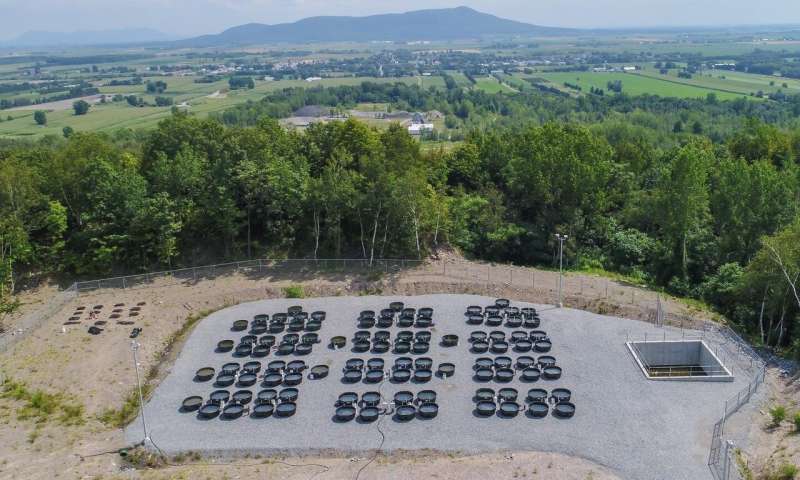
More information: Fugère V. et al. Community rescue in experimental phytoplankton communities facing severe herbicide pollution" Nature Ecology & Evolution. DOI: 10.1038/s41559-020-1134-5
Widely used weed killer harming biodiversity
by McGill University MARCH 2, 2020

Experimental ponds in Gault Nature Reserve. Credit: Vincent Fugère
One of the world's most widely used glyphosate-based herbicides, Roundup, can trigger loss of biodiversity, making ecosystems more vulnerable to pollution and climate change, say researchers from McGill University.
The widespread use of Roundup on farms has sparked concerns over potential health and environmental effects globally. Since the 1990s use of the herbicide boomed, as the farming industry adopted "Roundup Ready" genetically modified crop seeds that are resistant to the herbicide. "Farmers spray their corn and soy fields to eliminate weeds and boost production, but this has led to glyphosate leaching into the surrounding environment. In Quebec, for example, traces of glyphosate have been found in Montérégie rivers," says Andrew Gonzalez, a McGill biology professor and Liber Ero Chair in Conservation Biology.
To test how freshwater ecosystems respond to environmental contamination by glyphosate, researchers used experimental ponds to expose phytoplankton communities (algae) to the herbicide. "These tiny species at the bottom of the food chain play an important role in the balance of a lake's ecosystem and are a key source of food for microscopic animals. Our experiments allow us to observe, in real time, how algae can acquire resistance to glyphosate in freshwater ecosystems," says post-doctoral researcher Vincent Fugère.
Ecosystems adapt but at the cost of biodiversity
The researchers found that freshwater ecosystems that experience moderate contamination from the herbicide became more resistant when later exposed to a very high level of it—working as a form of "evolutionary vaccination." According to the researchers, the results are consistent with what scientists call "evolutionary rescue," which until recently had only been tested in the laboratory. Previous experiments by the Gonzalez group had shown that evolutionary rescue can prevent the extinction of an entire population when exposed to severe environmental contamination by a pesticide thanks to the rapid evolution.
However, the researchers note that the resistance to the herbicide came at a cost of plankton diversity. "We observed significant loss of biodiversity in communities contaminated with glyphosate. This could have a profound impact on the proper functioning of ecosystems and lower the chance that they can adapt to new pollutants or stressors. This is particularly concerning as many ecosystems are grappling with the increasing threat of pollution and climate change," says Gonzalez.
The researchers point out that it is still unclear how rapid evolution contributes to herbicide resistance in these aquatic ecosystems. Scientist already know that some plants have acquired genetic resistance to glyphosate in crop fields that are sprayed heavily with the herbicide. Finding out more will require genetic analyses that are currently under way by the team.
Explore further Probing the genetic basis of Roundup resistance in morning glory, a noxious weed
One of the world's most widely used glyphosate-based herbicides, Roundup, can trigger loss of biodiversity, making ecosystems more vulnerable to pollution and climate change, say researchers from McGill University.
The widespread use of Roundup on farms has sparked concerns over potential health and environmental effects globally. Since the 1990s use of the herbicide boomed, as the farming industry adopted "Roundup Ready" genetically modified crop seeds that are resistant to the herbicide. "Farmers spray their corn and soy fields to eliminate weeds and boost production, but this has led to glyphosate leaching into the surrounding environment. In Quebec, for example, traces of glyphosate have been found in Montérégie rivers," says Andrew Gonzalez, a McGill biology professor and Liber Ero Chair in Conservation Biology.
To test how freshwater ecosystems respond to environmental contamination by glyphosate, researchers used experimental ponds to expose phytoplankton communities (algae) to the herbicide. "These tiny species at the bottom of the food chain play an important role in the balance of a lake's ecosystem and are a key source of food for microscopic animals. Our experiments allow us to observe, in real time, how algae can acquire resistance to glyphosate in freshwater ecosystems," says post-doctoral researcher Vincent Fugère.
Ecosystems adapt but at the cost of biodiversity
The researchers found that freshwater ecosystems that experience moderate contamination from the herbicide became more resistant when later exposed to a very high level of it—working as a form of "evolutionary vaccination." According to the researchers, the results are consistent with what scientists call "evolutionary rescue," which until recently had only been tested in the laboratory. Previous experiments by the Gonzalez group had shown that evolutionary rescue can prevent the extinction of an entire population when exposed to severe environmental contamination by a pesticide thanks to the rapid evolution.
However, the researchers note that the resistance to the herbicide came at a cost of plankton diversity. "We observed significant loss of biodiversity in communities contaminated with glyphosate. This could have a profound impact on the proper functioning of ecosystems and lower the chance that they can adapt to new pollutants or stressors. This is particularly concerning as many ecosystems are grappling with the increasing threat of pollution and climate change," says Gonzalez.
The researchers point out that it is still unclear how rapid evolution contributes to herbicide resistance in these aquatic ecosystems. Scientist already know that some plants have acquired genetic resistance to glyphosate in crop fields that are sprayed heavily with the herbicide. Finding out more will require genetic analyses that are currently under way by the team.
Explore further Probing the genetic basis of Roundup resistance in morning glory, a noxious weed
More information: Fugère V. et al. Community rescue in experimental phytoplankton communities facing severe herbicide pollution" Nature Ecology & Evolution. DOI: 10.1038/s41559-020-1134-5
YouTube accused of being 'organ of radicalisation'
Algorithms push viewers to extremes, senior MP says at launch of report on far right

Yvette Cooper said YouTube had offered viewers neo-Nazi videos when she looked up a far-right group named in the report. Photograph: Sean Gallup/Getty Images
Ben Quinn, Molly Blackall and Vikram Dodd
Published on Mon 2 Mar 2020
Social media companies have been heavily criticised at the launch of a major report on the far right, with YouTube being labelled an “organ of radicalisation”.
The State of Hate 2020 report, by Hope Not Hate, also found the Conservative party had suspended more than 20 officials and activists, including six sitting councillors, who had posted Islamophobic comments on social media.
Yvette Cooper, the Labour chair of the Commons home affairs select committee, said on Monday that when she and others had set up an account to search for one of the far-right groups named in the report, YouTube had automatically suggested that viewers might want to watch neo-Nazi videos.
“Look up one thing out of curiosity and YouTube is ever willing to offer far, far more, often getting far more extreme and pushing further out to the extremes, because that is how YouTube works,” she said. “They have become an organ of radicalisation instead of taking responsibility, for that is the way their algorithms work.”
Cooper said a sense of decency which had always been a bulwark against the rise of the far right was on the decline. And she criticised both her own party for its “complicity” at a time when antisemitism was on the rise across Europe and the Conservatives for being “blind” to the Islamophobia in its own ranks.
Hope Not Hate’s report detailed the actions of Tories who had been suspended over Islamophobic social media posts.
In one screenshot taken by the campaign group, a Facebook account appearing to be that of the Nottinghamshire county councillor Steve Vickers published a post after the 2016 terrorist attack in Nice in which he said the London mayor, Sadiq Khan, “and his brethren” were “part of the problem”.
In response to the then prime minister, Theresa May, wishing Muslims a happy Eid on Facebook, screenshots show an account apparently belonging to the Harworth and Bircotes town councillor Sonia Armstrong leaving a long comment, much of it in capital letters.
“She should put a wig on, disguise herself and have a walk around these cities alone especially at night, and then tell us how much they give to GB and how well they have integrated,” she wrote.
She cited the “raping and killing of our people” as making citizens “too frightened to go out alone any more”, and said that “no one knows how much they enforce sharia law” because police turn “a blind eye to everything they do all because of political correctness”.
The report also accuses the Winchester city councillor Judith Clementson of using an anonymous Twitter account to post conspiracy theories about a “dangerous Muslim agenda for world domination”.
The Hounslow borough councillor Ranjit Pendhar Singh Gill allegedly “celebrated” Donald Trump’s election and his proposals to exclude Muslims from the US. And in another post he reportedly wrote about “75 million Muslim Turks” who planned to “infiltrate the UK”.
The dossier also indicts a number of ex-councillors. It states that Gail Hall, a Gwynedd county councillor from 2008-12, shared multiple anti-Muslim posts from far-right Facebook pages, calling Muslims “savages”. The report says she had also “liked” comments referring to Muslims as “scumbags” and encouraging them to “sling their hooks back to their ancestral homelands”.
Chris Meakin, the leader of the Conservative opposition in Southwark council during the 1970s and 80s, and who stood for election in Southwark council in 2002, also features in the report. It includes a screenshot of a post from an account matching his name, saying that Muslims did not deserve human rights “because of their animal-like behaviour”, and that it was “time to deploy the machine guns” against these “invaders”.
“Such an enemy must be eliminated,” it ends.
Hope Not Hate called on Conservative Campaign Headquarters “to take immediate action against these individuals”, and said it “will continue to demand that they take proper steps to tackle the Islamophobia crisis that has gripped the party at every level”.
It also said that allegations made against the Conservative party “painted a picture of a party that had a significant problem with anti-Muslim sentiment at local level”.
A party spokesperson told the Guardian: “All those found to be party members have been suspended immediately, pending investigation. The swift action we take on not just anti-Muslim discrimination but discrimination of any kind is testament to the seriousness with which we take such issues.”
A spokesperson for the Muslim Council of Britain blamed the Conservative party leadership for failing to tackle the issue and called for a formal inquiry by the Equality and Human Rights Commission.
“The Conservative party has an institutional problem of Islamophobia, which it seems unwilling to acknowledge, let alone tackle,” the spokesperson said.
“This latest evidence only adds to the wealth of examples we have seen in recent months, most of which have been met with indifference and inaction. Unlike those cases, it is welcome that action has been taken in these cases, but the suspensions must be properly followed through with appropriate sanctions where necessary, and transparency over who is readmitted into the party and why. Given the history of the party, we cannot be hopeful.
Ben Quinn, Molly Blackall and Vikram Dodd
Published on Mon 2 Mar 2020
Social media companies have been heavily criticised at the launch of a major report on the far right, with YouTube being labelled an “organ of radicalisation”.
The State of Hate 2020 report, by Hope Not Hate, also found the Conservative party had suspended more than 20 officials and activists, including six sitting councillors, who had posted Islamophobic comments on social media.
Yvette Cooper, the Labour chair of the Commons home affairs select committee, said on Monday that when she and others had set up an account to search for one of the far-right groups named in the report, YouTube had automatically suggested that viewers might want to watch neo-Nazi videos.
“Look up one thing out of curiosity and YouTube is ever willing to offer far, far more, often getting far more extreme and pushing further out to the extremes, because that is how YouTube works,” she said. “They have become an organ of radicalisation instead of taking responsibility, for that is the way their algorithms work.”
Cooper said a sense of decency which had always been a bulwark against the rise of the far right was on the decline. And she criticised both her own party for its “complicity” at a time when antisemitism was on the rise across Europe and the Conservatives for being “blind” to the Islamophobia in its own ranks.
Hope Not Hate’s report detailed the actions of Tories who had been suspended over Islamophobic social media posts.
In one screenshot taken by the campaign group, a Facebook account appearing to be that of the Nottinghamshire county councillor Steve Vickers published a post after the 2016 terrorist attack in Nice in which he said the London mayor, Sadiq Khan, “and his brethren” were “part of the problem”.
In response to the then prime minister, Theresa May, wishing Muslims a happy Eid on Facebook, screenshots show an account apparently belonging to the Harworth and Bircotes town councillor Sonia Armstrong leaving a long comment, much of it in capital letters.
“She should put a wig on, disguise herself and have a walk around these cities alone especially at night, and then tell us how much they give to GB and how well they have integrated,” she wrote.
She cited the “raping and killing of our people” as making citizens “too frightened to go out alone any more”, and said that “no one knows how much they enforce sharia law” because police turn “a blind eye to everything they do all because of political correctness”.
The report also accuses the Winchester city councillor Judith Clementson of using an anonymous Twitter account to post conspiracy theories about a “dangerous Muslim agenda for world domination”.
The Hounslow borough councillor Ranjit Pendhar Singh Gill allegedly “celebrated” Donald Trump’s election and his proposals to exclude Muslims from the US. And in another post he reportedly wrote about “75 million Muslim Turks” who planned to “infiltrate the UK”.
The dossier also indicts a number of ex-councillors. It states that Gail Hall, a Gwynedd county councillor from 2008-12, shared multiple anti-Muslim posts from far-right Facebook pages, calling Muslims “savages”. The report says she had also “liked” comments referring to Muslims as “scumbags” and encouraging them to “sling their hooks back to their ancestral homelands”.
Chris Meakin, the leader of the Conservative opposition in Southwark council during the 1970s and 80s, and who stood for election in Southwark council in 2002, also features in the report. It includes a screenshot of a post from an account matching his name, saying that Muslims did not deserve human rights “because of their animal-like behaviour”, and that it was “time to deploy the machine guns” against these “invaders”.
“Such an enemy must be eliminated,” it ends.
Hope Not Hate called on Conservative Campaign Headquarters “to take immediate action against these individuals”, and said it “will continue to demand that they take proper steps to tackle the Islamophobia crisis that has gripped the party at every level”.
It also said that allegations made against the Conservative party “painted a picture of a party that had a significant problem with anti-Muslim sentiment at local level”.
A party spokesperson told the Guardian: “All those found to be party members have been suspended immediately, pending investigation. The swift action we take on not just anti-Muslim discrimination but discrimination of any kind is testament to the seriousness with which we take such issues.”
A spokesperson for the Muslim Council of Britain blamed the Conservative party leadership for failing to tackle the issue and called for a formal inquiry by the Equality and Human Rights Commission.
“The Conservative party has an institutional problem of Islamophobia, which it seems unwilling to acknowledge, let alone tackle,” the spokesperson said.
“This latest evidence only adds to the wealth of examples we have seen in recent months, most of which have been met with indifference and inaction. Unlike those cases, it is welcome that action has been taken in these cases, but the suspensions must be properly followed through with appropriate sanctions where necessary, and transparency over who is readmitted into the party and why. Given the history of the party, we cannot be hopeful.
Ocean changes almost starved life of oxygen
by University of Exeter MARCH 2, 2020

Chemical changes in the oceans more than 800 million years ago almost destroyed the oxygen-rich atmosphere that paved the way for complex life on Earth, new research suggests.
Then, as now, the planet had an "oxidizing" atmosphere, driven by phytoplankton—the "plants" of the ocean—releasing oxygen during photosynthesis.
Then, as now, the planet had an "oxidizing" atmosphere, driven by phytoplankton—the "plants" of the ocean—releasing oxygen during photosynthesis.
However, new research from an international team including the University of Exeter and spanning Toulouse, Leeds, London and Nanjing, suggests ocean changes in the early Neoproterozoic era (from one billion to 800 million years ago) may have locked away phosphorus—a vital nutrient for life—limiting phytoplankton growth and oxygen release.
The study suggests the amount of phosphorus available remained "just sufficient" to support the oxidising atmosphere—preventing a return to the "reducing" (oxygen-poor) atmosphere that existed over a billion years earlier.
"Ocean chemistry in this period changed to become 'ferruginous' (rich in iron)," said Dr. Romain Guilbaud, of CNRS (Toulouse).
"We know ocean chemistry affects the cycle of phosphorus, but the impact on phosphorus availability at this time hadn't been investigated until now.
"By analysing ocean sediments, we found that iron minerals were very effective at removing phosphorus from the water."
Phytoplankton growth also boosts atmospheric oxygen because, having split carbon and oxygen and released the oxygen, plants die and their carbon is buried—so it cannot recombine with oxygen to form carbon dioxide.
Despite reductions in photosynthesis and this organic burial of carbon, both due to limited phosphorus, the study suggests oxygen in the atmosphere dropped no lower than 1% of current levels—"just enough" to maintain an oxidizing atmosphere.
"Our observations suggest significant potential variability in atmospheric oxygen concentrations across Earth's 'middle age'," said Professor Tim Lenton, Director of the Global Systems Institute at the University of Exeter.
He added: "One question about the emergence of complex life is why it didn't happen sooner.
"Lack of oxygen and lack of nutrients are two possible reasons, and our study suggests both of these may have been the case in the early Neoproterozoic era.
"In fact, if phosphorus levels in the water had dropped any lower, it could have tipped the world back into a 'reducing' atmosphere suitable for bacteria but not for complex life."
A return to a "reducing" atmosphere would have reversed the Great Oxidation Event, which occurred about 2.5 billion years ago, during which photosynthesis by cyanobacteria in the oceans introduced free oxygen to the atmosphere.
More information: Feifei Zhang et al. Extensive marine anoxia associated with the Late Devonian Hangenberg Crisis. March 2020 Earth and Planetary Science Letters 533:115976. DOI: 10.1016/j.epsl.2019.115976
Marine cyanobacteria do not survive solely on photosynthesis
by University of Córdoba MARCH 2, 2020

The researcher team that carried out the study Credit: University of Córdoba
Marine cyanobacteria are single-cell organisms that settled in the oceans millions of years ago. They are organisms that, by means of photosynthesis, create organic material by using inorganic substances. Specifically, the cyanobacteria known as Prochlorococcus and Synechococcus are the most abundant photosynthetic organisms on Earth and they generate a large part of the oxygen necessary for life, hence the oceans are the Earth's real lungs.
Despite the relevance of marine cyanobacteria in the origin and sustainment of life, they continue to be a neverending source of information. In fact, we knew nothing about Prochlorococcus until Professor Sallie W. Chisholm, at the Massachusetts Institute of Technology, discovered it in the 1980's. At the time, it was thought that these life-creating organisms got their nourishment solely from photosynthesis (like autotrophic organisms). However, research has shown that they also feed on organic compounds from their environment.
This hypothesis is corroborated by a recently published review article in The ISME Journal, a Nature group journal, led by researchers María del Carmen Muñoz and Guadalupe Gómez, from the Department of Biochemistry and Molecular Biology at the University of Cordoba, who, along with researchers from the Adaptations in the metabolism of nitrogen and carbon in Prochlorococcus group, Antonio López, José Ángel Moreno, Jesús Díez and José Manuel García, analyzed different studies dating back to the beginning of this century. These studies produced evidence that these organisms not only get nourishment from photosynthesis, but also are able to "eat" what they need from their environment.
This research group studied the mechanism of glucose transport in marine cyanobacteria, demonstrating that when they find compounds of this kind that they find appealing, such as glucose, amino acids and compounds containing iron, sulphur and phosphorus, these organisms consume them and become more competitive.
The study of vesicles (small compartments that store compounds) that spread marine cyanobacteria also supports this finding: vesicles contain organic compounds that can feed other bacteria, which provides evidence of how important the use of organic compounds is among these organisms.
This concept change is crucial at an environmental level since it helps to better understand cycles of elements such as carbon, iron, phosphorus and nitrogen. The essential role that cyanobacteria play when producing necessary oxygen for life and sequestering excess carbon dioxide from the atmosphere is strengthened by this review of its nourishment: if cyanobacteria have an advantage by using glucose and other organic compounds taken from their environment, life on Earth also benefits from these advantages.
Explore furtherOcean changes almost starved life of oxygen
More information: M. C. Muñoz-Marín et al, Mixotrophy in marine picocyanobacteria: use of organic compounds by Prochlorococcus and Synechococcus, The ISME Journal (2020). DOI: 10.1038/s41396-020-0603-9
Journal information: ISME Journal
Provided by University of Córdoba
Marine cyanobacteria are single-cell organisms that settled in the oceans millions of years ago. They are organisms that, by means of photosynthesis, create organic material by using inorganic substances. Specifically, the cyanobacteria known as Prochlorococcus and Synechococcus are the most abundant photosynthetic organisms on Earth and they generate a large part of the oxygen necessary for life, hence the oceans are the Earth's real lungs.
Despite the relevance of marine cyanobacteria in the origin and sustainment of life, they continue to be a neverending source of information. In fact, we knew nothing about Prochlorococcus until Professor Sallie W. Chisholm, at the Massachusetts Institute of Technology, discovered it in the 1980's. At the time, it was thought that these life-creating organisms got their nourishment solely from photosynthesis (like autotrophic organisms). However, research has shown that they also feed on organic compounds from their environment.
This hypothesis is corroborated by a recently published review article in The ISME Journal, a Nature group journal, led by researchers María del Carmen Muñoz and Guadalupe Gómez, from the Department of Biochemistry and Molecular Biology at the University of Cordoba, who, along with researchers from the Adaptations in the metabolism of nitrogen and carbon in Prochlorococcus group, Antonio López, José Ángel Moreno, Jesús Díez and José Manuel García, analyzed different studies dating back to the beginning of this century. These studies produced evidence that these organisms not only get nourishment from photosynthesis, but also are able to "eat" what they need from their environment.
This research group studied the mechanism of glucose transport in marine cyanobacteria, demonstrating that when they find compounds of this kind that they find appealing, such as glucose, amino acids and compounds containing iron, sulphur and phosphorus, these organisms consume them and become more competitive.
The study of vesicles (small compartments that store compounds) that spread marine cyanobacteria also supports this finding: vesicles contain organic compounds that can feed other bacteria, which provides evidence of how important the use of organic compounds is among these organisms.
This concept change is crucial at an environmental level since it helps to better understand cycles of elements such as carbon, iron, phosphorus and nitrogen. The essential role that cyanobacteria play when producing necessary oxygen for life and sequestering excess carbon dioxide from the atmosphere is strengthened by this review of its nourishment: if cyanobacteria have an advantage by using glucose and other organic compounds taken from their environment, life on Earth also benefits from these advantages.
Explore furtherOcean changes almost starved life of oxygen
More information: M. C. Muñoz-Marín et al, Mixotrophy in marine picocyanobacteria: use of organic compounds by Prochlorococcus and Synechococcus, The ISME Journal (2020). DOI: 10.1038/s41396-020-0603-9
Journal information: ISME Journal
Provided by University of Córdoba
NASA finds ex-Tropical Cyclone Esther moving back inland
by NASA's Goddard Space Flight Center MARCH 2, 2020
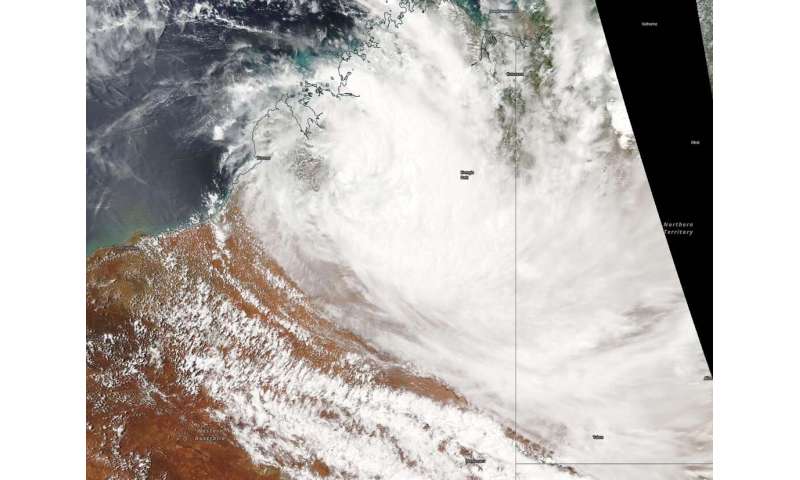
Ex-Tropical Cyclone Esther just won't give up. The storm formed in the South Pacific Ocean, tracked across Australia's Northern Territory and reached the Kimberley coast of Western Australia, and has now turned around. NASA's Aqua satellite provided forecasters with a visible image of the storm turning back into Western Australia on March 2.
On March 2, the Moderate Resolution Imaging Spectroradiometer or MODIS instrument that flies aboard NASA's Aqua satellite provided a visible image of Esther's remnant clouds that showed the storm moved back inland and away from the coast.
The Australian Bureau of Meteorology (ABM) issued a Flood Watch for the Tanami Desert, Central Desert, MacDonnell Ranges, Barkly, Georgina River and Simpson Desert on March 2. A flood warning is current for Sturt Creek District in Western Australia.
At 10:48 a.m. ACST on Monday, March 2, the ABM forecast said, "Rainfall is expected to increase from today with widespread daily totals of 50—80 mm [2 to 3.1 inches] and isolated falls of 150 mm [5.9 inches] expected for the northern Tanami Desert. Rainfall into Tuesday is expected to increase with widespread falls of 70—120 mm [2.8 to 4.7 inches] expected in the Central Desert and southeastern Tanami Desert. Isolated falls of 180 mm [7.0 inches] could also be possible in places.
Rainfall is expected to increase in the MacDonnell Ranges and southern Barkly during Tuesday with 40—100 mm [1.6 to 3.9 inches] daily totals expected into Wednesday. Rainfall extends to the upper Georgina River and Simpson Desert during Wednesday with daily rainfall totals 20—80 mm [0.8 to 3.14 inches] expected in many areas."
Many roads including major transportation routes in the flood watch area can expect to be affected on Mar. 2 and become impassable with some communities and homesteads becoming isolated.
Later today, ex-Tropical Cyclone Esther is expected to move into the northern Tanami District from the west as a strong arc of tropical low pressure.
Provided by NASA's Goddard Space Flight Center
5,000-year-old milk protein points to importance of dairying in eastern Eurasia
by Max Planck Society MARCH 2, 2020
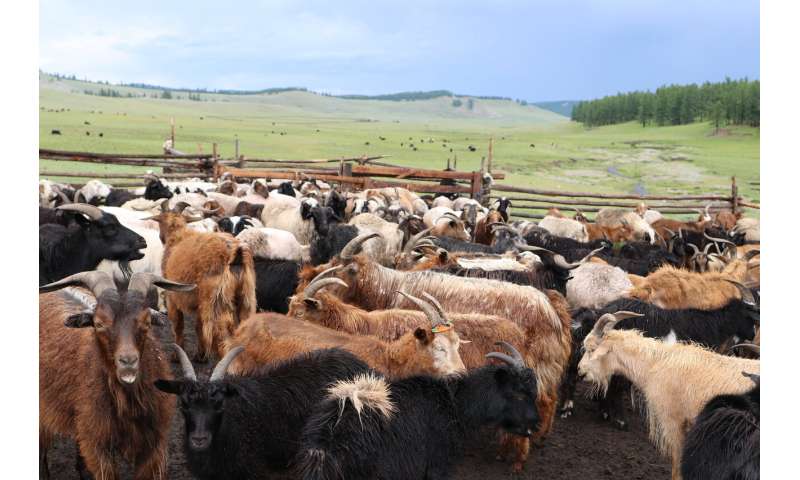
By analyzing milk proteins extracted from calcified dental plaque, researchers from the Max Planck Institute for the Science of Human History and their international partners present the earliest evidence for dairy consumption on the eastern Eurasian Steppe and uncover clues to the origin of mounted dairy pastoralism in Mongolia.
Today, dairy foods sustain and support millions around the world, including in Mongolia, where dairy foods make up to 50% of calories consumed during the summer. Although dairy-based pastoralism has been an essential part of life and culture in the eastern Eurasian Steppe for millennia, the eastward spread of dairying from its origin in southwest Asia and the development of these practices is little understood. The current study, led by Shevan Wilkin and Jessica Hendy of the Max Planck Institute for the Science of Human History, presents the earliest evidence for dairy consumption in East Asia, circa 3000 BCE, and offers insights into the arrival and evolution of dairy pastoralism in prehistoric Mongolia.
Earliest dairy consumption & a possible path of entry
The highly mobile nature of pastoralist societies and the severe winds of the Eastern Steppe make detecting occupied sites with direct evidence into the lives and culture of ancient Mongolians exceedingly rare. Instead, the researchers looked for clues in ritual human burial mounds, often marked by stone monuments and occasionally featuring satellite animal graves.
In collaboration with the National University of Mongolia, researchers analyzed dental calculus from individuals ranging from the Early Bronze Age to the Mongol Period. Three-quarters of all individuals contained evidence that they had consumed dairy foods, which demonstrates the widespread importance of this food source in both prehistoric and historic Mongolia. The study's results include the earliest direct evidence for dairy consumption in East Asia, identified in an individual from the Afanasievo site of Shatar Chuluu, which dates to roughly 3000 BCE. Previous DNA analysis on this individual revealed non-local genetic markers consistent with Western Steppe Herder populations, presenting Early Bronze Age Afanasievo migrations westward via the Russian Altai as a viable candidate for the introduction of dairy and domestic livestock into eastern Eurasia.
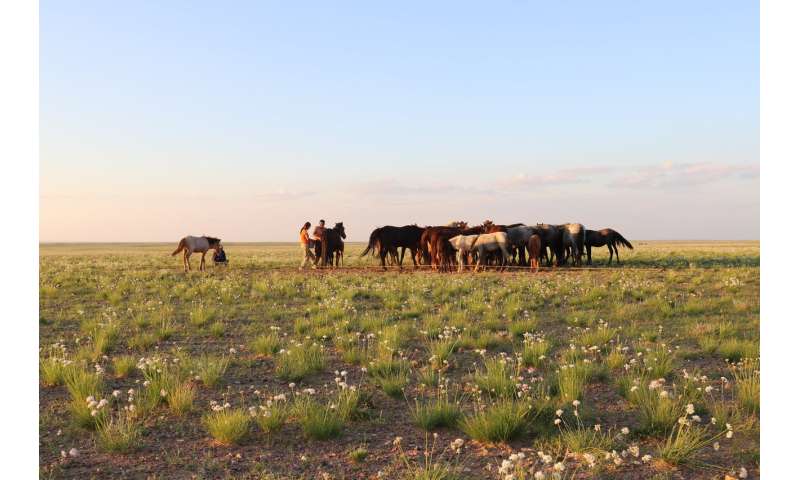
By sequencing the milk proteins extracted from the dental calculus, the scientists were able to determine which animal species were being used for dairy production, and thereby help to trace the progression of domestication, dairying, and pastoralism in the region. "Modern Mongolians use cow, sheep, goat, yak, camel, horse and reindeer for milk today, yet when each of these species were first utilized for dairy in Mongolia remains unclear," says Shevan Wilkin, lead author of the study. "What is clear is that the crucial renewable calories and hydration made available through the incorporation of dairying would have become essential across the arid and agriculturally challenging ancient Eastern Steppe."
The earliest individuals to show evidence of dairy consumption lived around 5000 years ago and consumed milk from ruminant species, such as cattle, sheep, and goats. A few thousand years later, at Bronze Age sites dated to after 1200 BCE, the researchers find the first evidence of horse milk consumption, occurring at the same time as early evidence for horse bridling and riding, as well as the use of horses at ritual burial sites.
In addition, the study shows that during the Mongol Empire circa 1200-1400 CE, people also consumed the milk of camels. "We are excited that through the analysis of proteins we are able to see the consumption of multiple different animal species, even sometimes in the same individual. This gives us a whole new insight into ancient dairying practices," says Jessica Hendy, senior author of the study.
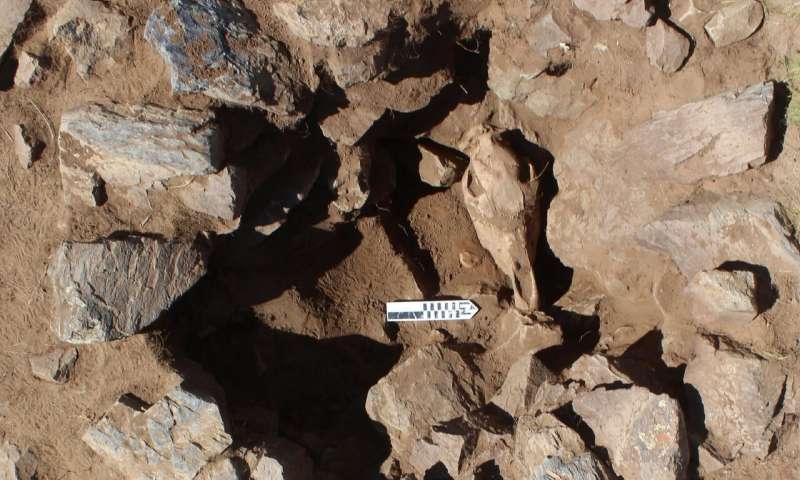
Millenia after the first evidence of horse milk consumption, horses remain vital to the daily lives of many in modern Mongolia, where mounted pastoralists rely on them to manage large herds of livestock, transport people and supplies, and provide a primary source of meat and milk. "Our findings suggest that the incorporation of horses into dairy pastoralism in Eastern Eurasia was closely linked to a broader economic transformation in the use of horses for riding, movement, and diet," says William Taylor of the University of Colorado-Boulder, one of the study's coauthors.
Although the earliest individual sampled in this study showed evidence of dairy consumption, the researchers hope future studies will examine individuals from previous time periods. "In order to form a clearer picture of the origins of dairying in this region, we need to understand the impact of western steppe herder migrations and confirm whether dairying was occurring in Mongolia prior to their arrival," Shevan Wilkin concludes.
The study is published in Nature Ecology & Evoluti
More information: Dairy pastoralism sustained eastern Eurasian steppe populations for 5,000 years, Nature Ecology & Evolution (2020). DOI: 10.1038/s41559-020-1120-y , https://nature.com/articles/s41559-020-1120-y
Journal information: Nature Ecology & Evolution
Disposal of wastewater from hydraulic fracturing poses dangers to drivers
by University of Illinois at Urbana-Champaign MARCH 2, 2020

Environmental concerns about hydraulic fracturing—aka "fracking," the process by which oil and gas are extracted from rock by injecting high-pressure mixtures of water and chemicals—are well documented, but according to a paper co-written by a University of Illinois at Urbana-Champaign environmental economics expert, the technique also poses a serious safety risk to local traffic.
New research from Yilan Xu ("E-Lan SHE"), a professor of agricultural and consumer economics at Illinois, shows that the growing traffic burden in fracking boomtowns from trucks hauling wastewater to disposal sites resulted in a surge of road fatalities and severe accidents.
"Fracking requires large amounts of water, and it subsequently generates a lot of wastewater," she said. "When trucks need to transport all that water within a narrow window of time to a disposal site, that poses a safety threat to other drivers on the road—especially since fracking occurs mostly in these boomtowns where the roadway infrastructure isn't built up enough to handle heavy truck traffic."
The study examined how fracking-related trucking affected the number of fatal crashes in the Bakken Formation in North Dakota from 2006-14, using the timing of fracking operations near certain road segments.
The researchers identified a causal link between fracking-related trucking and fatal traffic crashes, finding that an additional post-fracking well within six miles of the road segments led to 8% more fatal crashes and 7.1% higher per-capita costs in accidents.
"Our back-of-the-envelope calculation suggests that an additional 17 fatal crashes took place per year across the sampled road segments, representing a 49% increase relative to the annual crash counts of the drilling counties in North Dakota in 2006," Xu said. "That's a significant number when you're talking about a sparsely populated area like North Dakota.
"And besides the fatality and injury costs in fatal crashes quantified in our study, other costs may occur as well, including injury costs in nonfatal crashes and indirect expenditures on emergency services, insurance administrative costs, and infrastructure maintenance and replacement."
To lessen the negative impact on traffic fatalities as well as the severity of traffic accidents, the study proposes a tax that can be charged per well to internalize the costs of fracking-related trucking activities, similar to the impact fees implemented in energy-rich towns in Pennsylvania that yield hundreds of millions of dollars per year for the state.
"The tax could serve as an economic instrument that affects operators' drilling and fracking decisions and thus alleviate the hazard of the associated truck traffic indirectly," Xu said. "Likewise, a toll fee by miles driven by trucks could be collected on highways to absorb the negative impacts of fracking-related trucking."
The study also sheds light on more practical measures that local governments can undertake to curb the traffic risks associated with fracking.
"Since many fracking-induced fatal crashes take place in the daytime rush hours, local governments could adopt policies such as making a high occupancy vehicle lane for trucks carrying wastewater. An active traffic alert and warning system with live well-operations updates could also help drivers monitor traffic and avoid exposure to road hazards," she said.
Moreover, the paper calls for the active involvement of the oil and gas industry to seek ways to improve their workplace safety and mitigate the traffic hazard of fracking to road users.
"Our findings suggest that oil and gas operators could redistribute the traffic loads over time to avoid concentrated water hauling during peak hours," Xu said. "In the long run, since a well may need to be fracked multiple times over its productive life, operators may improve the water supply system by constructing water wells serving multiple well pads via a piping system. They could also develop the onsite wastewater treatment and disposal facilities as opposed to trucking wastewater over long distances. Such measures would reduce the long-term transport costs and the associated traffic effects."
The findings should give local and federal policymakers information when conducting due diligence and evaluating the regional costs and benefits of shale energy development, Xu said.
"Our study provides an estimate based on the North Dakota experience where population density and traffic volume is relatively low, but our findings have implications for other regions planning future shale development."
Study finds communities need to be proactive about fracking
More information: Minhong Xu et al, Fraccidents: The Impact of Fracking on Road Traffic Deaths, Journal of Environmental Economics and Management (2020). DOI: 10.1016/j.jeem.2020.102303
by University of Illinois at Urbana-Champaign MARCH 2, 2020

Environmental concerns about hydraulic fracturing—aka "fracking," the process by which oil and gas are extracted from rock by injecting high-pressure mixtures of water and chemicals—are well documented, but according to a paper co-written by a University of Illinois at Urbana-Champaign environmental economics expert, the technique also poses a serious safety risk to local traffic.
New research from Yilan Xu ("E-Lan SHE"), a professor of agricultural and consumer economics at Illinois, shows that the growing traffic burden in fracking boomtowns from trucks hauling wastewater to disposal sites resulted in a surge of road fatalities and severe accidents.
"Fracking requires large amounts of water, and it subsequently generates a lot of wastewater," she said. "When trucks need to transport all that water within a narrow window of time to a disposal site, that poses a safety threat to other drivers on the road—especially since fracking occurs mostly in these boomtowns where the roadway infrastructure isn't built up enough to handle heavy truck traffic."
The study examined how fracking-related trucking affected the number of fatal crashes in the Bakken Formation in North Dakota from 2006-14, using the timing of fracking operations near certain road segments.
The researchers identified a causal link between fracking-related trucking and fatal traffic crashes, finding that an additional post-fracking well within six miles of the road segments led to 8% more fatal crashes and 7.1% higher per-capita costs in accidents.
"Our back-of-the-envelope calculation suggests that an additional 17 fatal crashes took place per year across the sampled road segments, representing a 49% increase relative to the annual crash counts of the drilling counties in North Dakota in 2006," Xu said. "That's a significant number when you're talking about a sparsely populated area like North Dakota.
"And besides the fatality and injury costs in fatal crashes quantified in our study, other costs may occur as well, including injury costs in nonfatal crashes and indirect expenditures on emergency services, insurance administrative costs, and infrastructure maintenance and replacement."
To lessen the negative impact on traffic fatalities as well as the severity of traffic accidents, the study proposes a tax that can be charged per well to internalize the costs of fracking-related trucking activities, similar to the impact fees implemented in energy-rich towns in Pennsylvania that yield hundreds of millions of dollars per year for the state.
"The tax could serve as an economic instrument that affects operators' drilling and fracking decisions and thus alleviate the hazard of the associated truck traffic indirectly," Xu said. "Likewise, a toll fee by miles driven by trucks could be collected on highways to absorb the negative impacts of fracking-related trucking."
The study also sheds light on more practical measures that local governments can undertake to curb the traffic risks associated with fracking.
"Since many fracking-induced fatal crashes take place in the daytime rush hours, local governments could adopt policies such as making a high occupancy vehicle lane for trucks carrying wastewater. An active traffic alert and warning system with live well-operations updates could also help drivers monitor traffic and avoid exposure to road hazards," she said.
Moreover, the paper calls for the active involvement of the oil and gas industry to seek ways to improve their workplace safety and mitigate the traffic hazard of fracking to road users.
"Our findings suggest that oil and gas operators could redistribute the traffic loads over time to avoid concentrated water hauling during peak hours," Xu said. "In the long run, since a well may need to be fracked multiple times over its productive life, operators may improve the water supply system by constructing water wells serving multiple well pads via a piping system. They could also develop the onsite wastewater treatment and disposal facilities as opposed to trucking wastewater over long distances. Such measures would reduce the long-term transport costs and the associated traffic effects."
The findings should give local and federal policymakers information when conducting due diligence and evaluating the regional costs and benefits of shale energy development, Xu said.
"Our study provides an estimate based on the North Dakota experience where population density and traffic volume is relatively low, but our findings have implications for other regions planning future shale development."
Study finds communities need to be proactive about fracking
More information: Minhong Xu et al, Fraccidents: The Impact of Fracking on Road Traffic Deaths, Journal of Environmental Economics and Management (2020). DOI: 10.1016/j.jeem.2020.102303
How quickly do flower strips in cities help the local bees?
by Pensoft Publishers MARCH 2, 2020
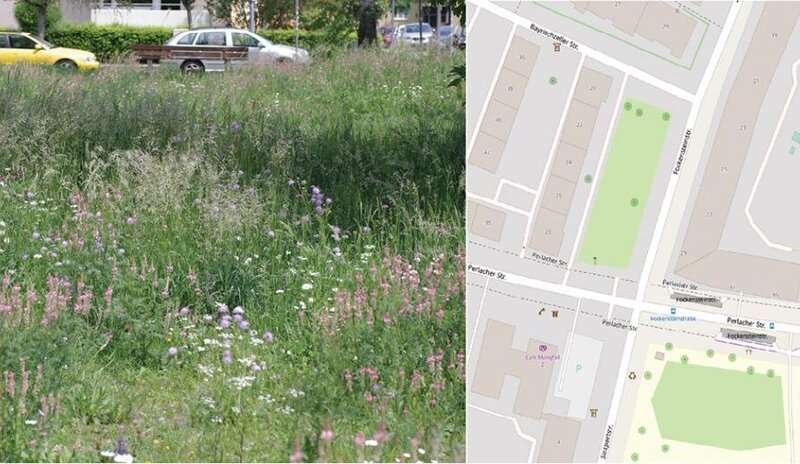
Insects rely on a mix of floral resources for survival. Populations of bees, butterflies, and flies are currently rapidly decreasing due to the loss of flower-rich meadows. In order to deal with the widespread loss of fauna, the European Union supports "greening" measures, for example, the creation of flower strips.
A group of scientists from the University of Munich, led by Prof. Susanne S. Renner, has conducted the first quantitative assessment of the speed and distance over which urban flower strips attract wild bees, and published the results of the study in the open-access Journal of Hymenoptera Research.
Flower strips are human-made patches of flowering plants that provide resources for flower-visiting insects and insect- and seed-feeding birds. Previous experiments have proved their conservation value for enhancing biodiversity in agricultural landscapes.
The success of flower strips in maintaining populations of solitary bees depends on the floristic composition, distance from suitable nesting sites, and distance from other habitats maintaining stable populations of bees. To study the attractiveness of the flower strips in urban landscapes, the scientists used an experimental set-up of nine 1,000 sq. meters flower strips recently established in Munich by a local bird conservation agency.
"We identified and counted the bees visiting flowers on each strip and then related these numbers to the total diversity of Munich's bee fauna and to the diversity at different distances from the strips. Our expectation was that newly planted flower strips would attract a small subset of mostly generalist, non-threatened species and that oligolectic species (species using pollen from a taxonomically restricted set of plants) would be underrepresented compared to the city's overall species pool," shared Prof. Susanne S. Renner.
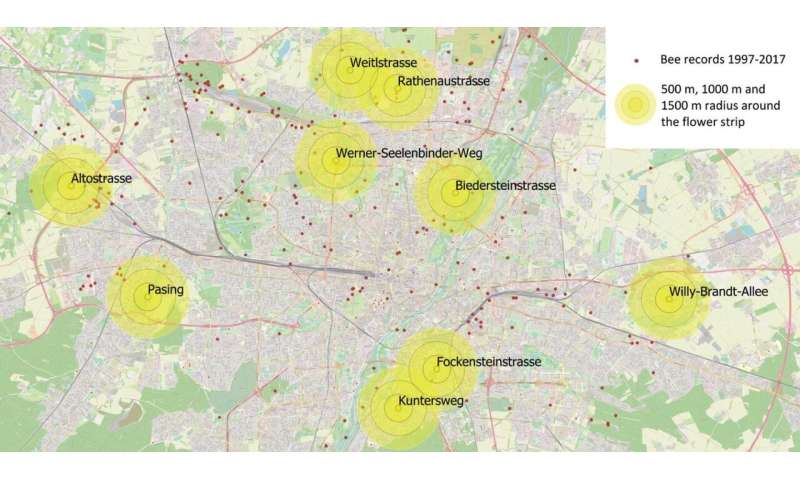
Bees need time to discover new habitats, but the analysis showed that the city's wild bees managed to do that in just one year so that the one-year-old flower strips attracted one-third of the 232 species recorded in Munich between 1997 and 2017.
Surprisingly, the flower strips attracted a random subset of Munich's bee species in terms of pollen specialization. At the same time, as expected, the first-year flower-strip visitors mostly belonged to common, non-threatened species.
The results of the study support that flower strip plantings in cities provide extra support for pollinators and act as an effective conservation measure. The authors therefore strongly recommend the flower strip networks implemented in the upcoming Common Agricultural Policy (CAP) reform in the European Union.
More information: Michaela M. Hofmann et al, One-year-old flower strips already support a quarter of a city's bee species, Journal of Hymenoptera Research (2020). DOI: 10.3897/jhr.75.47507
Journal information: Journal of Hymenoptera Research
Directed species loss from species-rich forests strongly decreases productivity
by University of Zurich
MARCH 2, 2020
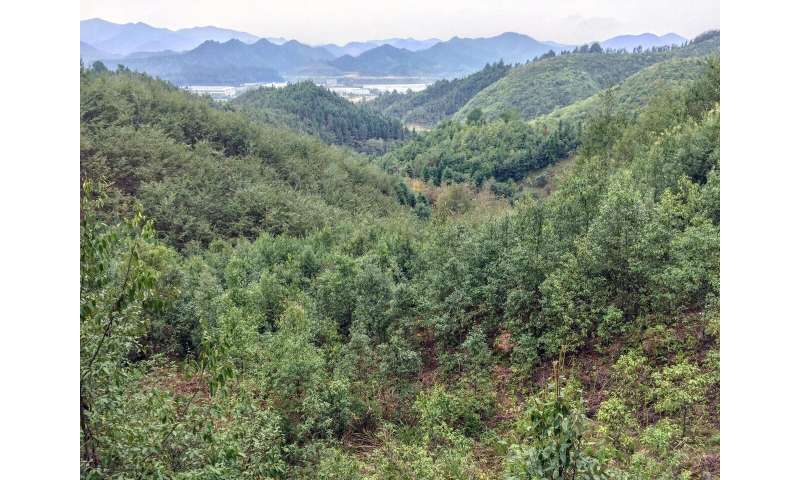 The field trial BEF-China is carried out in Xingangshan in the province of Jiangxi in southeast China. Credit: Yuanyuan Huang
The field trial BEF-China is carried out in Xingangshan in the province of Jiangxi in southeast China. Credit: Yuanyuan Huang
At high species richness, directed loss, but not random loss, of tree species strongly decreases forest productivity. This is shown by data from a big forest project in China in which the University of Zurich is involved. Previous studies based on random species loss could therefore bias the predictions of how more realistic extinction scenarios are likely to affect ecosystem functioning.
The forest biodiversity experiment BEF-China began in 2009 with the collaboration among institutions in China, Germany and Switzerland and is one of the world's biggest field experiments. In the subtropical forests in southeastern China the international team planted over 500 plots of 670 square meters of land with 400 trees each—with each plot receiving between one and 16 tree species in various combinations. The researchers simulated both random and directed species extinction scenarios and analyzed the data.
Directed loss of species reduces productivity
After eight years, directed species loss in species-rich forest ecosystems, in which evolutionarily distinct species had higher extinction risks, showed much stronger reductions in forest productivity than did treatments that were subject to random species loss. "These findings have significant implications for biodiversity conservation and climate mitigation, because more productive forests also removed more carbon dioxide from the air," says Bernhard Schmid, professor at the Department of Geography of the University of Zurich (UZH) and last author of the study.
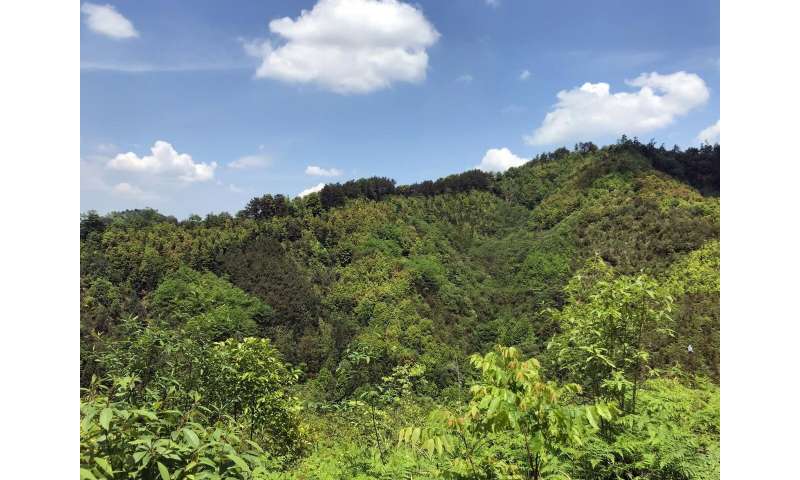 BEF-China comprises 500 plots of forest land with different and varying numbers of tree species. Credit: Yuanyuan Huang
BEF-China comprises 500 plots of forest land with different and varying numbers of tree species. Credit: Yuanyuan Huang
Diversity alone does not protect against losses
"Our results suggest that species loss can severely hamper ecosystem functioning already at high species richness, when many species still remain in the ecosystem. It challenges the decade-long assumption derived from studies based on random species loss," says Schmid. This assumption is that species loss from high-diversity communities would have only little impact on ecosystem functioning, because the remaining species could take over the functions of extinct species due to species redundancy.
Extinct species missing from the network
Why could directed species loss lead to such strong productivity reduction? "We think two processes associated with directed species loss might lead to the results. When species loss is directed, we may lose the most functionally distinct species first, if that functionally distinctiveness is also the cause of extinction," explains first author of the study Yuxin Chen, former post-doc at UZH and now associate professor at Xiamen University in China. "Species do not live independently, but participate in complex networks of species interactions. Losing species can change these interaction networks. The loss of species interactions contributed significantly to the observed results."
China responds with new laws
The ongoing impacts of a severe coronavirus epidemic this winter has prompted China to speed up biosecurity legislation and elevate it to a national security issue. The biosecurity law would cover various areas including conserving biodiversity. "Our research is grounded in one of the diversity hotspots in China. The findings are timely for supporting the legislation of biosecurity," says Keping Ma professor at the Chinese Academy of Sciences and co-founder of the BEF-China experiment. "Diversity loss from species-rich forests could also increase the risk of pest and disease outbreaks. Some other research teams are studying this issue."
Explore furtherSpecies-rich forests store twice as much carbon as monocultures
More information: Yuxin Chen et al. Directed Species Loss Reduces Community Productivity in a Subtropical Forest-Biodiversity Experiment. Nature Ecology & Evolution. 2 March 2020, DOI: 10.1038/s41559-020-1127-4
Journal information: Nature Ecology & Evolution
Provided by University of Zurich
by University of Zurich
MARCH 2, 2020
 The field trial BEF-China is carried out in Xingangshan in the province of Jiangxi in southeast China. Credit: Yuanyuan Huang
The field trial BEF-China is carried out in Xingangshan in the province of Jiangxi in southeast China. Credit: Yuanyuan HuangAt high species richness, directed loss, but not random loss, of tree species strongly decreases forest productivity. This is shown by data from a big forest project in China in which the University of Zurich is involved. Previous studies based on random species loss could therefore bias the predictions of how more realistic extinction scenarios are likely to affect ecosystem functioning.
The forest biodiversity experiment BEF-China began in 2009 with the collaboration among institutions in China, Germany and Switzerland and is one of the world's biggest field experiments. In the subtropical forests in southeastern China the international team planted over 500 plots of 670 square meters of land with 400 trees each—with each plot receiving between one and 16 tree species in various combinations. The researchers simulated both random and directed species extinction scenarios and analyzed the data.
Directed loss of species reduces productivity
After eight years, directed species loss in species-rich forest ecosystems, in which evolutionarily distinct species had higher extinction risks, showed much stronger reductions in forest productivity than did treatments that were subject to random species loss. "These findings have significant implications for biodiversity conservation and climate mitigation, because more productive forests also removed more carbon dioxide from the air," says Bernhard Schmid, professor at the Department of Geography of the University of Zurich (UZH) and last author of the study.
 BEF-China comprises 500 plots of forest land with different and varying numbers of tree species. Credit: Yuanyuan Huang
BEF-China comprises 500 plots of forest land with different and varying numbers of tree species. Credit: Yuanyuan HuangDiversity alone does not protect against losses
"Our results suggest that species loss can severely hamper ecosystem functioning already at high species richness, when many species still remain in the ecosystem. It challenges the decade-long assumption derived from studies based on random species loss," says Schmid. This assumption is that species loss from high-diversity communities would have only little impact on ecosystem functioning, because the remaining species could take over the functions of extinct species due to species redundancy.
Extinct species missing from the network
Why could directed species loss lead to such strong productivity reduction? "We think two processes associated with directed species loss might lead to the results. When species loss is directed, we may lose the most functionally distinct species first, if that functionally distinctiveness is also the cause of extinction," explains first author of the study Yuxin Chen, former post-doc at UZH and now associate professor at Xiamen University in China. "Species do not live independently, but participate in complex networks of species interactions. Losing species can change these interaction networks. The loss of species interactions contributed significantly to the observed results."
China responds with new laws
The ongoing impacts of a severe coronavirus epidemic this winter has prompted China to speed up biosecurity legislation and elevate it to a national security issue. The biosecurity law would cover various areas including conserving biodiversity. "Our research is grounded in one of the diversity hotspots in China. The findings are timely for supporting the legislation of biosecurity," says Keping Ma professor at the Chinese Academy of Sciences and co-founder of the BEF-China experiment. "Diversity loss from species-rich forests could also increase the risk of pest and disease outbreaks. Some other research teams are studying this issue."
Explore furtherSpecies-rich forests store twice as much carbon as monocultures
More information: Yuxin Chen et al. Directed Species Loss Reduces Community Productivity in a Subtropical Forest-Biodiversity Experiment. Nature Ecology & Evolution. 2 March 2020, DOI: 10.1038/s41559-020-1127-4
Journal information: Nature Ecology & Evolution
Provided by University of Zurich
Exposure to 'fake news' during the 2016 US election has been overstated: study
by Dartmouth College
MARCH 2, 2020

by Dartmouth College
MARCH 2, 2020

Credit: CC0 Public Domain
Since the 2016 U.S. presidential election, debates have raged about the reach of so-called "fake news" websites and the role they played during the campaign. A study published in Nature Human Behaviour finds that the reach of these untrustworthy websites has been overstated.
To assess the audience for "fake news," researchers at Dartmouth, Princeton and the University of Exeter measured visits to these dubious and unreliable websites during the period before and immediately after the election using an online survey of 2,525 Americans and web traffic data collected by YouGov Pulse (Oct. 7—Nov. 16, 2016) from respondents' laptops or desktop computers. This method avoids the problems with asking people to recall which websites they visited, an approach that is plagued with measurement error.
According to the findings, less than half of all Americans visited an untrustworthy website. Moreover, untrustworthy websites accounted for only six percent of all Americans' news diets on average.
Visits to dubious news sites differed sharply along ideological and partisan lines. Content from untrustworthy conservative sites accounted for nearly 5 percent of people's news diets compared to less than 1 percent for untrustworthy liberal sites. Respondents who identified themselves as Trump supporters were also more likely to visit an untrustworthy site (57 percent) than those who indicated that they were Clinton supporters (28 percent).
The data also revealed that Facebook was the most prominent gateway to untrustworthy websites; respondents were more likely to have visited Facebook than Google, Twitter or a webmail platform such as Gmail in the period immediately before visiting an untrustworthy website.
Finally, the study demonstrates that fact-checking websites appeared to be relatively ineffective in reaching the audiences of untrustworthy websites. Only 44 percent of respondents who visited such a website also visited a fact-checking site during the study, and almost none of them had read a fact-check debunking specific claims made in a potentially questionable article.
"These findings show why we need to measure exposure to 'fake news' rather than just assuming it is ubiquitous online," said Brendan Nyhan, a professor of government at Dartmouth. "Online misinformation is a serious problem, but one that we can only address appropriately if we know the magnitude of the problem."
Explore furtherLSU professor relaunches fake news and disinformation resource website
More information: Andrew M. Guess et al. Exposure to untrustworthy websites in the 2016 US election, Nature Human Behaviour (2020). DOI: 10.1038/s41562-020-0833-x
Journal information: Nature Human Behaviour
Provided by Dartmouth College
Since the 2016 U.S. presidential election, debates have raged about the reach of so-called "fake news" websites and the role they played during the campaign. A study published in Nature Human Behaviour finds that the reach of these untrustworthy websites has been overstated.
To assess the audience for "fake news," researchers at Dartmouth, Princeton and the University of Exeter measured visits to these dubious and unreliable websites during the period before and immediately after the election using an online survey of 2,525 Americans and web traffic data collected by YouGov Pulse (Oct. 7—Nov. 16, 2016) from respondents' laptops or desktop computers. This method avoids the problems with asking people to recall which websites they visited, an approach that is plagued with measurement error.
According to the findings, less than half of all Americans visited an untrustworthy website. Moreover, untrustworthy websites accounted for only six percent of all Americans' news diets on average.
Visits to dubious news sites differed sharply along ideological and partisan lines. Content from untrustworthy conservative sites accounted for nearly 5 percent of people's news diets compared to less than 1 percent for untrustworthy liberal sites. Respondents who identified themselves as Trump supporters were also more likely to visit an untrustworthy site (57 percent) than those who indicated that they were Clinton supporters (28 percent).
The data also revealed that Facebook was the most prominent gateway to untrustworthy websites; respondents were more likely to have visited Facebook than Google, Twitter or a webmail platform such as Gmail in the period immediately before visiting an untrustworthy website.
Finally, the study demonstrates that fact-checking websites appeared to be relatively ineffective in reaching the audiences of untrustworthy websites. Only 44 percent of respondents who visited such a website also visited a fact-checking site during the study, and almost none of them had read a fact-check debunking specific claims made in a potentially questionable article.
"These findings show why we need to measure exposure to 'fake news' rather than just assuming it is ubiquitous online," said Brendan Nyhan, a professor of government at Dartmouth. "Online misinformation is a serious problem, but one that we can only address appropriately if we know the magnitude of the problem."
Explore furtherLSU professor relaunches fake news and disinformation resource website
More information: Andrew M. Guess et al. Exposure to untrustworthy websites in the 2016 US election, Nature Human Behaviour (2020). DOI: 10.1038/s41562-020-0833-x
Journal information: Nature Human Behaviour
Provided by Dartmouth College
Subscribe to:
Posts (Atom)

